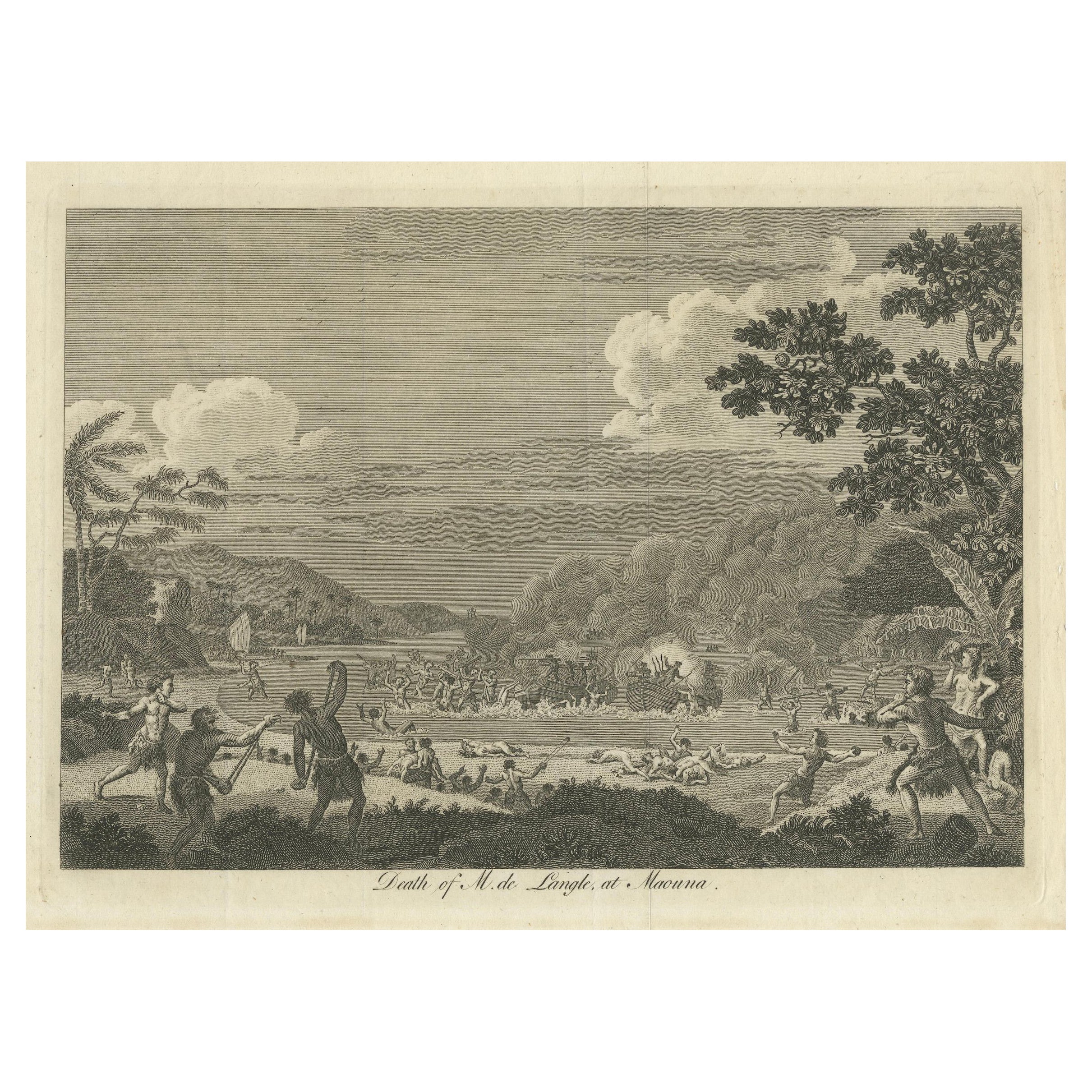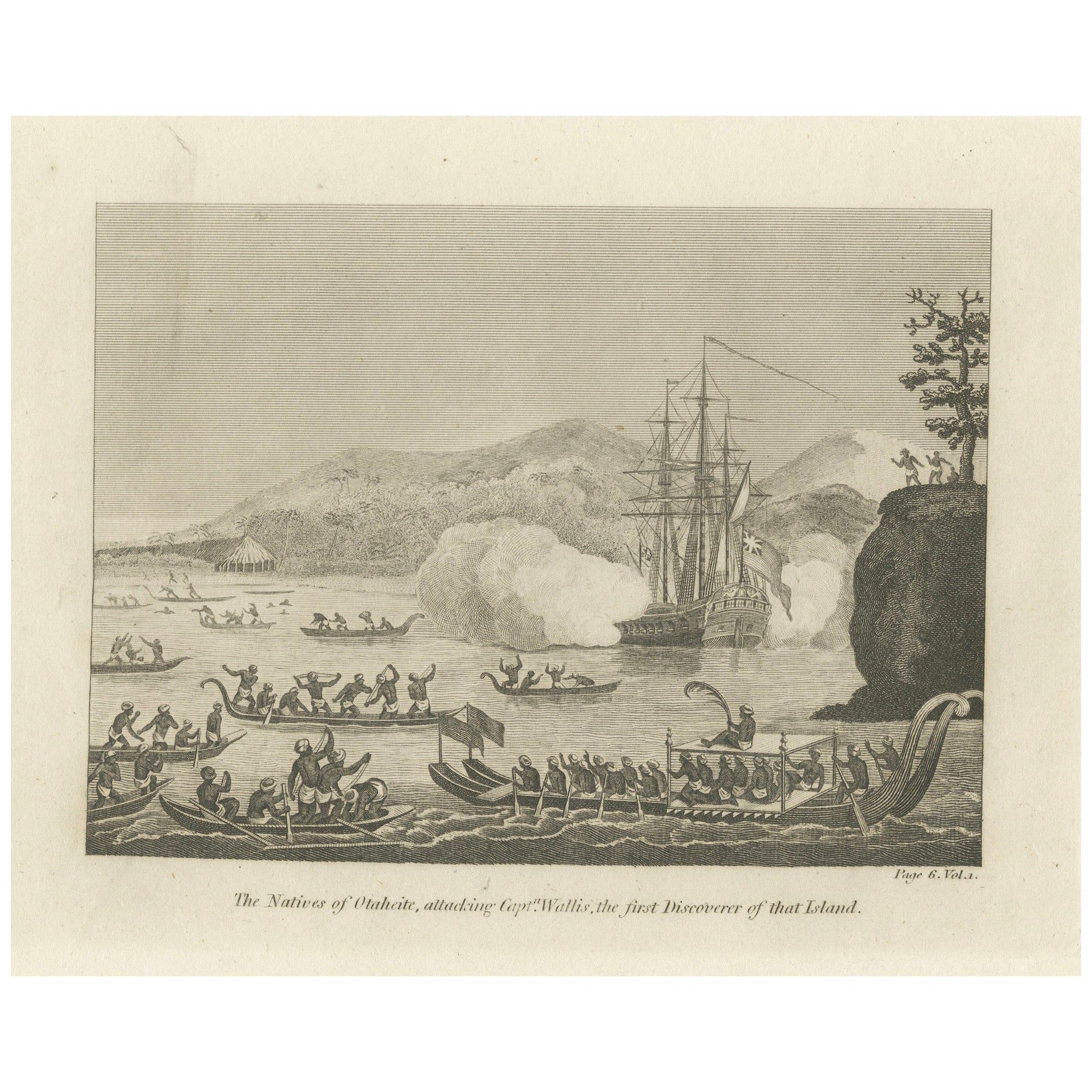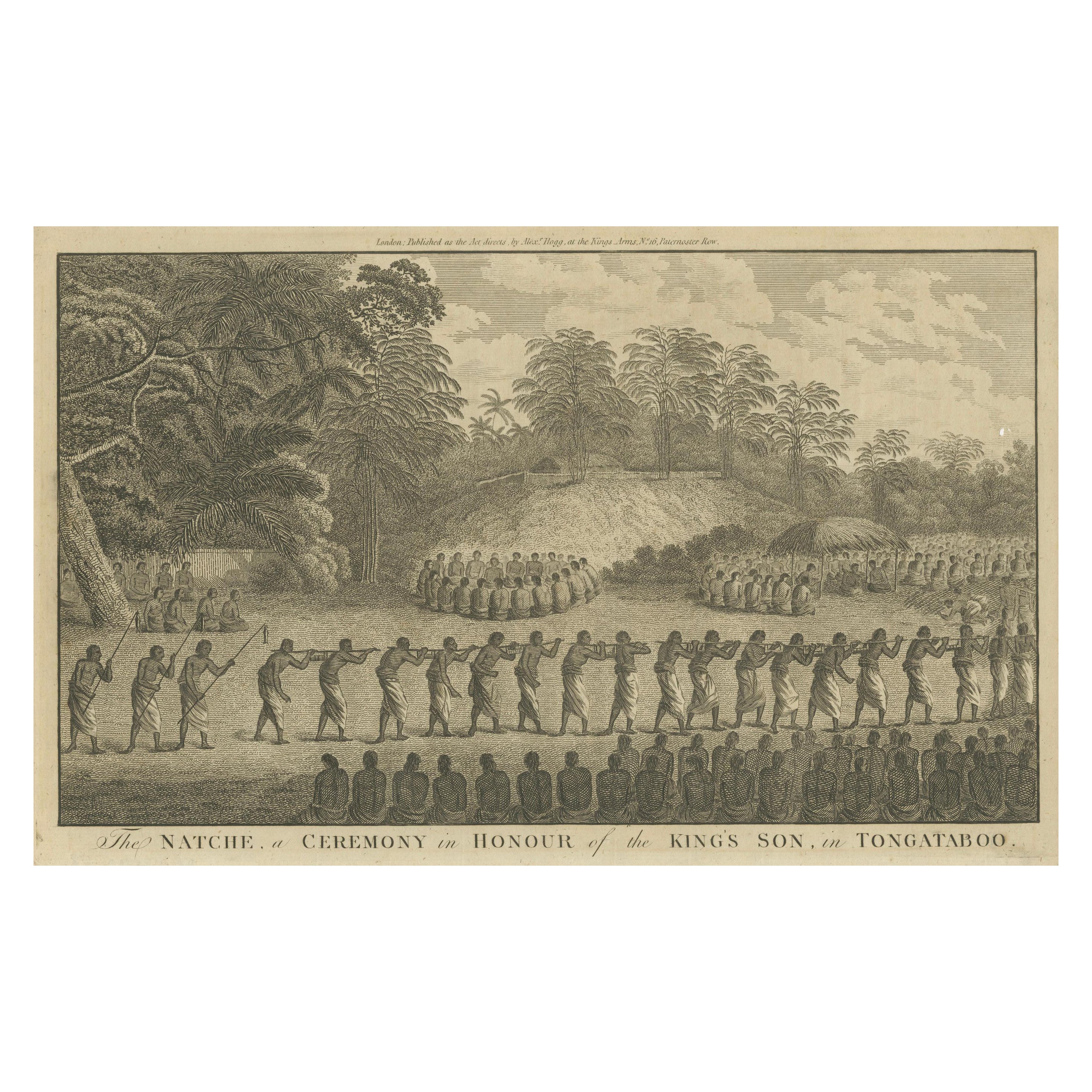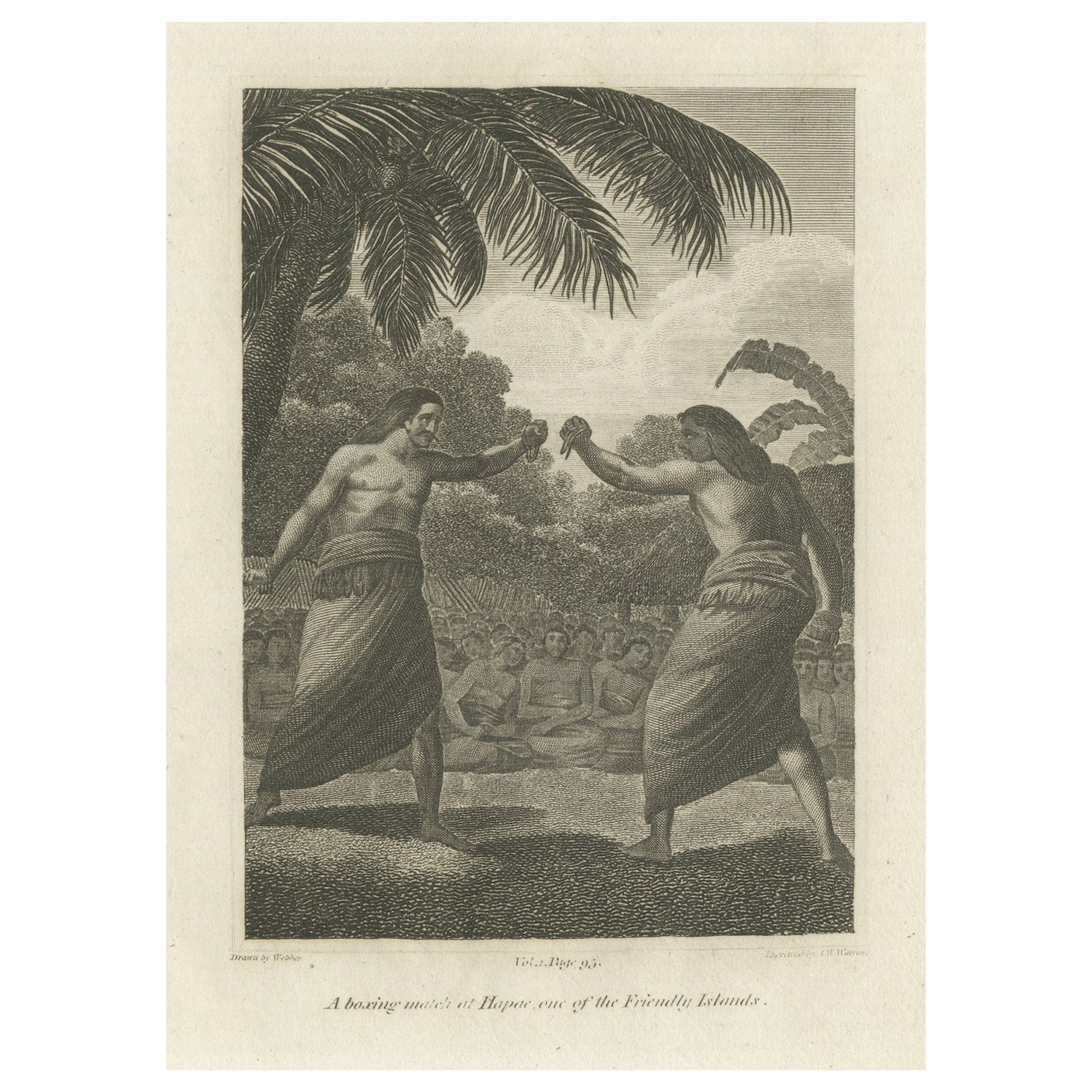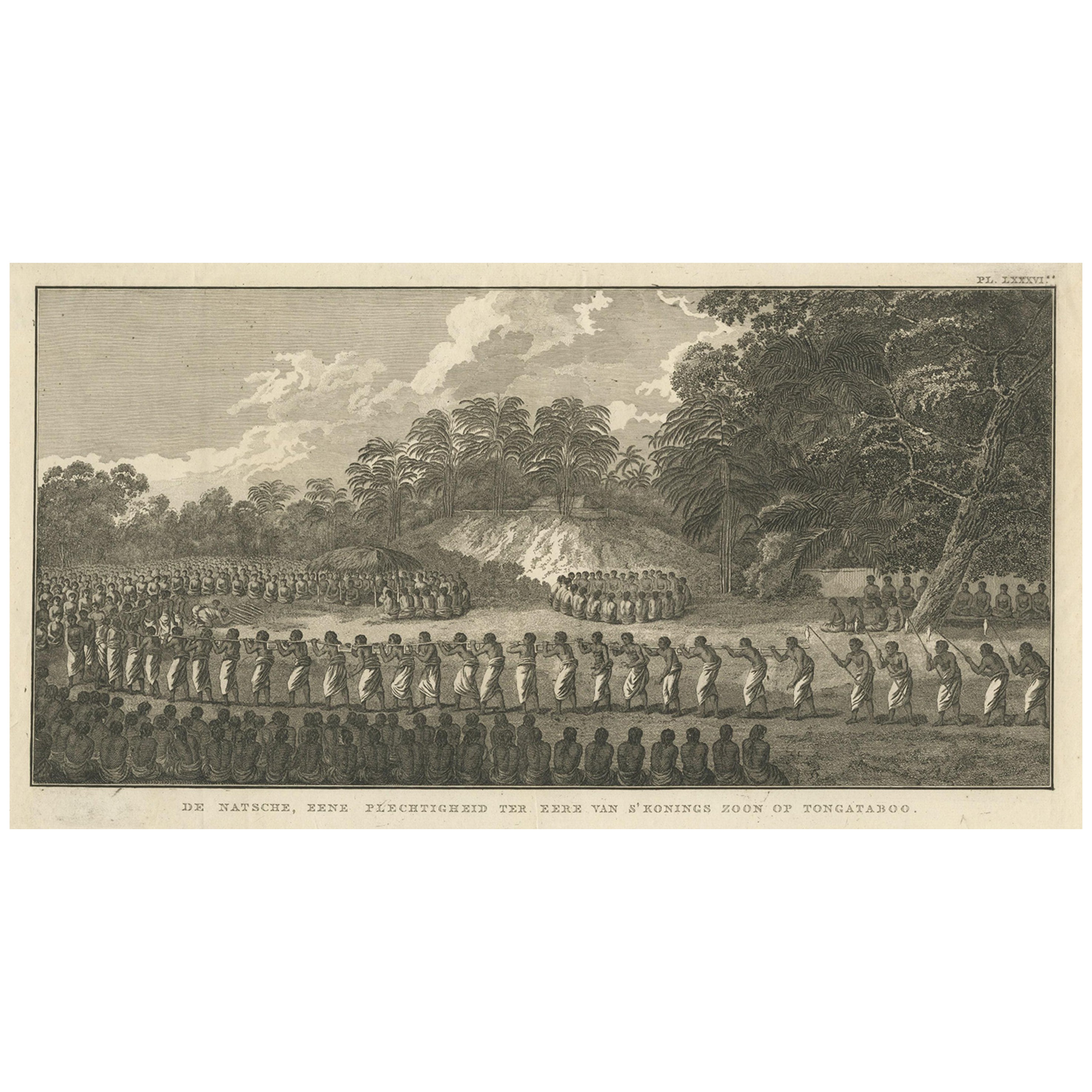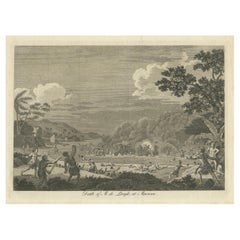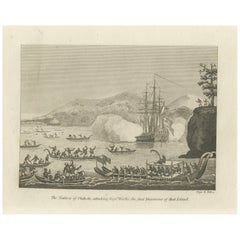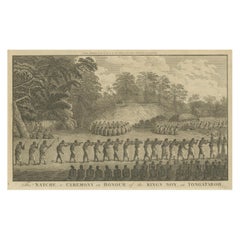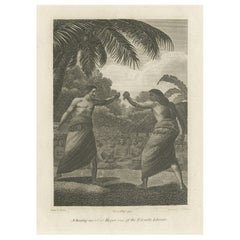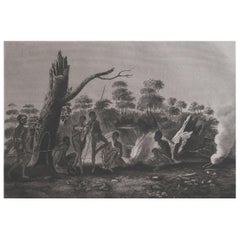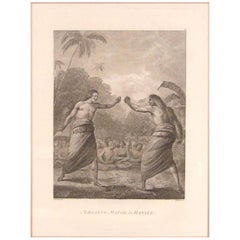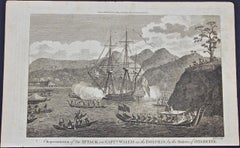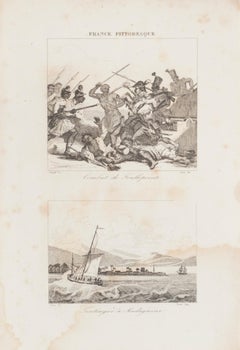Items Similar to Confrontation and Culture: Samoan Warrior Engagement, Published in 1820
Want more images or videos?
Request additional images or videos from the seller
1 of 7
Confrontation and Culture: Samoan Warrior Engagement, Published in 1820
$239.63
$299.5420% Off
£178.39
£222.9920% Off
€200
€25020% Off
CA$328.23
CA$410.2920% Off
A$365.07
A$456.3320% Off
CHF 190.63
CHF 238.2820% Off
MX$4,442.45
MX$5,553.0720% Off
NOK 2,434.58
NOK 3,043.2220% Off
SEK 2,283.21
SEK 2,854.0120% Off
DKK 1,522.53
DKK 1,903.1620% Off
Shipping
Retrieving quote...The 1stDibs Promise:
Authenticity Guarantee,
Money-Back Guarantee,
24-Hour Cancellation
About the Item
The engraving is captioned as "Mode of Fighting in the Navigator's Islands" and depicts a scene of conflict among the indigenous people of the Navigator's Islands, now known as the Samoan Islands. The text at the bottom of the engraving indicates that it was published by Alexander Hogg at King’s Arms, No. 16, Paternoster Row, London.1820.
The drama happened during the La Pérouse expedition. The people in the two boats under the command of Jean-François de Galaup, comte de La Pérouse, who were killed, were part of a tragic encounter in December 1787. This incident took place in the Samoan Islands at Aasu Bay, Tutuila Island.
The La Pérouse expedition was a significant French exploratory voyage in the Pacific, and the conflict that led to the deaths of members of the crew was one of the unfortunate occurrences during the expedition. The event involved a group from the expedition, led by one of La Pérouse’s officers, Paul Antoine Fleuriot de Langle, attempting to collect water and having a deadly encounter with local Samoans, resulting in the death of de Langle and at least 12 other members of the crew.
The exact names of all the individuals who lost their lives in this encounter are not commonly recorded in general historical accounts, but Fleuriot de Langle is most frequently noted due to his rank and role in the expedition. The detailed names of the others may be found in the logs and records of the La Pérouse expedition if they have been preserved and made available by historians or archives.
- Dimensions:Height: 7.68 in (19.5 cm)Width: 10.24 in (26 cm)Depth: 0 in (0.02 mm)
- Materials and Techniques:Paper,Engraved
- Period:
- Date of Manufacture:1820
- Condition:Good. Light soiling, mostly around the borders, due to age and handling. Plate-marks cut short except at the bottom. Small hole in the middle, only visible when holding up against the light. Study the image carefully.
- Seller Location:Langweer, NL
- Reference Number:Seller: BG-13599-71stDibs: LU3054337996602
About the Seller
5.0
Recognized Seller
These prestigious sellers are industry leaders and represent the highest echelon for item quality and design.
Platinum Seller
Premium sellers with a 4.7+ rating and 24-hour response times
Established in 2009
1stDibs seller since 2017
2,508 sales on 1stDibs
Typical response time: <1 hour
- ShippingRetrieving quote...Shipping from: Langweer, Netherlands
- Return Policy
Authenticity Guarantee
In the unlikely event there’s an issue with an item’s authenticity, contact us within 1 year for a full refund. DetailsMoney-Back Guarantee
If your item is not as described, is damaged in transit, or does not arrive, contact us within 7 days for a full refund. Details24-Hour Cancellation
You have a 24-hour grace period in which to reconsider your purchase, with no questions asked.Vetted Professional Sellers
Our world-class sellers must adhere to strict standards for service and quality, maintaining the integrity of our listings.Price-Match Guarantee
If you find that a seller listed the same item for a lower price elsewhere, we’ll match it.Trusted Global Delivery
Our best-in-class carrier network provides specialized shipping options worldwide, including custom delivery.More From This Seller
View AllThe Death of Commander Fleuriot de Langle and His Men at Maouna, Samoa, 1797
Located in Langweer, NL
The engraving depicts a harrowing and chaotic scene from an 18th-century exploration, specifically the tragic event involving Commander Fleuriot de Langle and his men. The scene is s...
Category
Antique 1790s Prints
Materials
Paper
$402 Sale Price
20% Off
Free Shipping
Encounters at Dawn: The Standoff at Tahiti with Captain Wallis Engraved, 1801
Located in Langweer, NL
Title: "The Natives of Otaheite Attacking Capt. Wallis, The First Discoverer of that Island"
This engraving depicts a significant historical encounter between the natives of Tahiti ...
Category
Antique Early 1800s Prints
Materials
Paper
$536 Sale Price
20% Off
Free Shipping
Royal Celebration in Tongatapu: The Natche Ceremony Engraved in circa 1785
Located in Langweer, NL
An authentic antique engraving titled "The NATCHE: a Ceremony in Honour of the KING'S SON, in TONGATABOO." It is likely from a work related to the voyages of Captain James Cook miss...
Category
Antique 1780s Prints
Materials
Paper
$153 Sale Price
20% Off
A Boxing Match, in Hapaee, One of the Hawaii Islands, circa 1780
Located in Langweer, NL
John Webber created the engraving titled "A Boxing Match, in Hapaee, one of the Friendly Islands." Webber was indeed an artist who accompanied Captain James Cook on his third voyage ...
Category
Antique Late 18th Century Prints
Materials
Paper
Rhythms of the Pacific: A Communal Dance in Tonga, Engraving Published in 1812
Located in Langweer, NL
The engraving depicts a serene and communal scene labeled as "Dance in the Friendly Isles." The Friendly Isles is an older name for the Kingdom of Tonga in the South Pacific. This pi...
Category
Antique Early 19th Century Prints
Materials
Paper
$249 Sale Price
20% Off
Free Shipping
De Natsche – Ceremony for the King's Son, Tonga c.1795
Located in Langweer, NL
De Natsche – Ceremony for the King's Son, Tonga c.1795
This antique print depicts a grand ceremony held in honour of the son of the King of Tonga, known as the Natsche, in the villa...
Category
Antique Early 1800s European Prints
Materials
Paper
$565 Sale Price
20% Off
You May Also Like
Original Antique Ethnographical Print, Figures, New South Wales, Australia, 1809
Located in St Annes, Lancashire
Wonderful ethnographical print.
A copper-plate engraving after Lesieur
Published by Sherwood, Neely & Jones. Dated 1809
Unframed.
Category
Antique Early 1800s English Folk Art Prints
Materials
Paper
Copper Engraving "Boxing Match in Hapaee from Cook's Voyages" after John Webber
By John Webber
Located in San Francisco, CA
J. Webber: A boxing match in Hapaee (Hawaii). An original copper plate engraving on paper depicting a boxing match as witnessed during Cook's third voyage...
Category
Antique 18th Century English Decorative Art
Materials
Paper
Attack on Captain Wallis When He Discovered Tahiti: Original 18th C. Engraving
Located in Alamo, CA
"A Representation of the Attack on Captain Wallis in the Dolphin by the Natives of Otaheite (Tahiti)" is an engraving created by the artist Sparrow based on an engraving in John Hawk...
Category
1780s Landscape Prints
Materials
Engraving
Battle - Original lithograph - 19th Century
Located in Roma, IT
Battle is an original lithograph on paper realized by an Anonymous artist of the XIX century.
From series " France Pittoresque" (title at the top center).
Included two impressive ...
Category
19th Century Figurative Prints
Materials
Lithograph
"King of the Friendly Islands" (Tonga); Engraving from Captain Cook's 3rd Voyage
By John Webber
Located in Alamo, CA
"Poulaho, King of the Friendly Islands, Drinking Kava" is an engraving created by William Sharp (1749-1824), from a drawing by John Webber (1752-1793), who was the artist on Captain James Cook's 3rd and final voyage of discovery. It was published in the atlas of "A Voyage to the Pacific Ocean Undertaken by the Command of His Majesty, for Making Discoveries in the Northern Hemisphere", the official British Admirality sanctioned journal published upon completion of the voyage in London in 1784 by Strahan & Cadell.
Captain Cook visited Tonga on his 3rd voyage, which he named The Friendly Islands because of the warm welcome he and his crew received, unlike some of the other more hostile Pacific islands. The engraving depicts Cook and his men observed a kava ceremony at the village of Mu’a on Tongatapu. King Paulaho sits in the centre foreground, his back to the spectator with a man kneeling before him. The ceremonial mat depicted behind Paulaho indicates that nobody was allowed to sit behind him. The figure in the centre holds a single cup, referring to the Tongan custom of offering the cup to the king first. Kava is native to the islands of the South Pacific and was first described for English readers in 1768 by Captain James Cook. The kava root has been used for centuries as a central feature of ceremonies and celebrations because it was able to bring about a calming and pleasant social atmosphere. The root was crushed and processed into coconut milk to become the focal ceremonial beverage, simply referred to as kava.
This engraving is presented in a Koa wood frame and a white mat. Koa wood is legendary in Hawaii. There are occasional faint spots, but the print is otherwise in very good condition. This amazing Koa wood is native to Hawaii and it is known for the deep rich colors and varied grain pattern. Koa has an honored heritage in Hawaii and is highly revered and sacred. The word “koa” means “warrior” in Hawaiian. The warriors of King Kamehameha the Great, created canoes and weapons from a wood plentiful on the Big Island of Hawaii. This wood became synonymous with the warriors themselves, and it became known as koa.
There are three other engravings listed from the official journal of Captain Cook's 3rd voyage available that are presented in identical Koa wood frames and mats (LU117324682422, LU117324684052, LU117324684032). They would make a wonderful grouping for a display of 2, 3 or 4 prints. A discount is available for a grouping depending on the number of items included.
Captain Cook is remembered as one of the greatest explorers and navigators in history. His explorations included Australia, New Zealand and islands of the South Pacific and the northwest coast of North America. Hawaii was discovered by Captain Cook during this voyage. Hawaii was originally called The Sandwich Islands in honor of The Earl of Sandwich...
Category
1780s Realist Figurative Prints
Materials
Engraving
Reception for Captain Cook, Tonga: Original 18th C. Engraving, Cook's 3rd Voyage
By John Webber
Located in Alamo, CA
"The Reception of Capt. Cook in Hapaee" is an original 18th century engraving from a drawing by John Webber (1751-1793), who was the artist who accompanied Captain Cook on his third ...
Category
1780s Landscape Prints
Materials
Engraving
